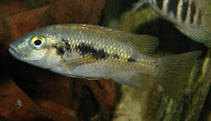| Diagnosis: |
Dorsal spines (total): 15-16; Dorsal soft rays (total): 10-11; Anal spines: 3-3; Anal soft rays: 8-9; Vertebrae: 29. Diagnosis: profile of the snout evenly decurved, descending to a nearly horizontal mouth; narrow interorbital space (24-27% head length)(Ref. 53940, 53949). Lower jaw not, or only slightly inclined from the horizontal; lower pharyngeal jaw only slightly longer than wide (Ref. 81260). Dentigerous area of lower pharyngeal bone longer than anterior blade in young and of characteristic shape, with a narrow anterior apical portion (Ref. 53949). Blade of lower pharyngeal bone 0.7-0.95 times median length of toothed area; 3 regular rows of teeth; upper series of black blotches parallel to dorsal outline; black band of uneven width extending from opercular spot to anterior part of caudal peduncle; posterior end of caudal peduncle with vertical blotch meeting its fellow over top; fins colorless; tilapia mark absent (Ref. 53940).
Description: body moderatley deep (Ref. 52307), body depth 34.4-37.5% SL (Ref. 81260). Profile of snout evenly and strongly decurved (Ref. 53940, 81260), descending to a nearly horizontal mouth (Ref. 53940). Snout blunt; lower jaw slightly inclined away from horizontal when mouth closed (Ref. 81260). 3 regular rows of jaw teeth (Ref. 53940, 53949, 81260), outer row of upper jaw with 45-55 fine, obliquely spatulate bicuspid teeth, inner rows tricuspid (Ref. 81260). Dentigerous area of lower pharyngeal bone longer than anterior blade in young and of characteristic shape, with a narrow anterior apical portion; maxillary not quite reaching vertical from anterior edge of eye (Ref. 53949). Narrow interorbital space (24-27% head length) (Ref. 53940, 81260). Gill-rakers short (Ref. 53949), the lower very short (Ref. 53949, 81260). 2 series of scales on cheek; roof of pharynx in front of and at sides of upper pharyngeal teeth rather richly provided with a swollen, grooved epithelial area, but not with a hanging pad; scales cycloid; last anal spine about as long as last dorsal spine, and stronger; pelvic fins with outermost soft ray the longest, extending nearly or quite to anus, in males to genital papilla; caudal fin scaly at the base and about halfway along the upper and lower rays (Ref. 53949).
Coloration: base body coloration pale yellow-brown, darker dorsally (Ref. 81260). Upper series of black blotches parallel to the dorsal outline (Ref. 53940, 53949, 81260). Black band of uneven width extending from the opercular spot to the anterior part of the caudal peduncle (Ref. 52307, 53940, 53949, 81260). Posterior end of caudal peduncle with vertical blotch meeting its fellow over the top; tilapia mark absent (Ref. 53940, 53949). Fins colorless; larger individuals with dark grey snout and back, and upper series of blotches no longer visible (Ref. 53940). Branchiostegal membrane, isthmus and sometimes the chest black (Ref. 52307, 53940), which is probable related to gonad condition and not to size (Ref. 53940). Outer edge of pelvic fins white (Ref. 53949). Body silvery to grey; back sometimes more yellowish-brown; younger individuals often with 4-5 dark markings at the base of the dorsal fin (Ref. 52307). |
| Biology: |
Feeds on algae, small insects and fish eggs (Ref. 52307). Also kleptoparasite of freshwater crabs (Ref. 53950). Ovophilic mouthbrooder with both sexes as possible incubator; from aquarium observations: a few days prior to spawning, both partners remain close together for much of the time; the genital papilla of the female is clearly visible immediately before spawning and is much broader and larger than the male's; females are normally more successful than males when it comes to brooding the fry; when mouthbrooding, which ends about 3 weeks post-spawning, the specimens are relatively shy and prefer to lie silently near the bottom in secluded areas; once free swimming, juveniles normally do not return to the parent's mouth again (Ref. 52307). |

